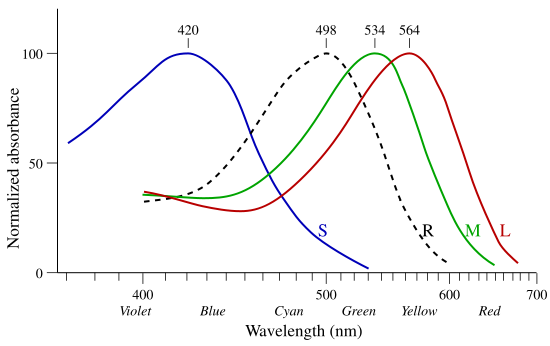Trichromacy
Overview
Trichromacy is the condition of possessing three independent channels for conveying color information, derived from the three different cone types.[1] Organisms with trichromacy are called trichromats.
The normal explanation of trichromacy is that the organism's retina contains three types of color receptors (called cone cells in vertebrates) with different absorption spectra. In practice the number of such receptor types may be greater than three, since different types may be active at different light intensities. In vertebrates with three types of cone cells, at low light intensities the rod cells may contribute to color vision, giving a small region of tetrachromacy in the color space.
Humans and other closely related primates are usually trichromats, as are female New World monkeys of most species, and both male and female howler monkeys. Recent research suggests that trichromacy may also be quite general among marsupials. Most other mammals are currently thought to be dichromats, with only two types of cone (though the possibility of limited trichromacy at low light levels where the rods and cones are both active). Some species of insects (such as honeybees) are also trichromats, being sensitive to ultraviolet, blue and green instead of blue, green and red.
Trichromatic color vision

Trichromatic color vision is the ability of humans and some other animals to see different colors, mediated by interactions among three types of color-sensing cone cells. The trichromatic color theory began in the 18th century, when Thomas Young proposed that color vision was a result of three different photoreceptors. Hermann von Helmholtz later expanding on Young's ideas using color-matching experiments which showed that people with normal vision needed three wavelengths to create the normal range of colors. Each of the three types of cones in the retina of the eye contains a different type of photosensitive pigment, which is composed of a transmembrane protein called opsin and a light-sensitive molecule called 11-cis retinal. Each different pigment is especially sensitive to a certain wavelength of light (that is, the pigment is most likely to produce a cellular response when it is hit by a photon with the specific wavelength to which that pigment is most sensitive). The three types of cones are L, M, and S, which have pigments that respond best to light of long (especially 560 nm), medium (530 nm), and short (420 nm) wavelengths respectively.[2]
Since the likelihood of response of a given cone varies not only with the wavelength of the light that hits it but also with its intensity, the brain would not be able to discriminate different colors if it had input from only one type of cone. Thus, interactions between at least two types of cone is necessary to produce the ability to perceive color. With at least two types of cones, the brain can compare the signals from each type and determine both the intensity and color of the light. For example, moderate stimulation of a medium-wavelength cone cell could mean that it is being stimulated by very bright red (long-wavelength) light, or by not very intense yellowish-green light. But very bright red light would produce a stronger response from L cones than from M cones, while not very intense yellowish light would produce a stronger response from M cones than from other cones (counterintuitively, a "strong response" here refers to a large hyperpolarization, since rods and cones communicate that they are being stimulated by not firing). Thus trichromatic color vision is accomplished by using combinations of cell responses.
See also
References
- ↑ http://tigger.uic.edu/~hilbert/Glossary.html
- ↑ Kandel ER, Schwartz JH, Jessell TM. Principles of Neural Science, 4th ed., pp.182-185. McGraw-Hill, New York (2000). ISBN 0-8385-7701-6
- Arrese, CA; Oddy, AY; Runham, PB; Hart, NS; Shand, J; Hunt, DM (2005). "Cone topography and spectral sensitivity in two potentially trichromatic marsupials, the quokka (Setonix brachyurus) and quenda (Isoodon obesulus)." Proceedings of the Royal Society of London Series B. 272(1595), 791-796.
- Calderone, JB; Jacobs, GH (2003). "Spectral properties and retinal distribution of ferret cones." Visual Neuroscience. 20(1), 11-17.
- Calderone, JB; Reese, BE; Jacobs, GH (2003). "Topography of photoreceptors and retinal ganglion cells in the spotted hyena (Crocuta crocuta)." Brain Behavior and Evolution. 62(4), 182-192.
- Rowe, Michael H (2002). "Trichromatic color vision in primates." News in Physiological Sciences. 17(3), 93-98. [1]
External links
- The Straight Dope: "Are cats and dogs really color-blind? How do they know?"